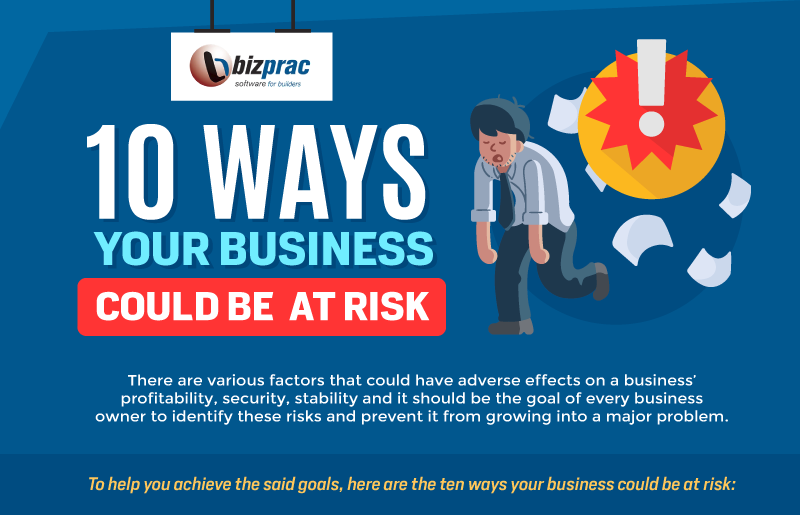Contents
Identifying and mitigating risks is one of the most critical – yet often overlooked duties of a business owner and manager. Regardless of its size and nature, any business is exposed to some kind of threats, such as natural calamities and cybersecurity risks. However, there are also some risks that are specific to some industries – and only the business owner that can identify and assess the potential impact of these risks can jumpstart a mitigation plan to protect their organisation.
Download the checklist to help you identify the 10 ways your business could be at risk.
Ways Your Business Could Be at Risk
Successful small businesses like Bizprac knows the different risks facing all types and sizes of companies these days:
1. Natural disasters
From fires, flooding, tornadoes, and earthquakes – calamities are inevitable and destructive, making it one of the most apprehended incidents by business owners. That is why it is essential for every business to be prepared and equipped with emergency plans, supplies, exits and meeting points, and data backup.
2. Health and safety risks
The workforce is the driving force behind the survival and success of any business. That is why it is the responsibility of every employer to prioritise their employees’ health and safety through insurances, compliance with health and safety regulations, and regular risk assessments.
3. Non-compliance with regulations
A plethora of labour, health, sanitary and safety, consumer data protection and taxation regulations among others are in place mostly to ensure fair competition and quality services and product in the market. The consequence of non-compliance with corporate regulations are fines and in worse cases, involuntary dissolution or imprisonment.
4. Regulatory and government policy changes
Government regulations and policies are often subject to changes for improvement purposes that is why every business should adapt to it. Failure to adapt to the said changes result in the same consequences of non-compliance with regulations.
5. Security risks
Threats such as robbery, fraud, extortion, and terrorism are threats that no business can afford not to plan for. Using security devices like video surveillance cameras, smart locks, and fingerprint safes are ideal but will not suffice. A comprehensive security plan and a thorough employee education program regarding security measures are still best.
6. Cyber risks
With the business sector almost fully reliable on digital and online platforms, many businesses become susceptible to cyber risks like hacking and online scams because of using weak passwords, downloading malicious software and applications, and clicking on suspicious attachments and links. Because of this, hackers gain access to the business’ sensitive data. To minimise this risk, you should install security software for your company gadgets and educate your employees regarding the mentioned tactics that hackers use.
7. Economic and financial risks
In the event of an economic downturn, every business suffers, but not everyone survives and recovers. To endure and recover from the recession, you should first identify the risks, analyse its impacts, evaluate and treat it, and continue developing your risk management plan.
8. Loss of competitive advantage
As technology advances and market preferences changes, the level of competition in many industries has grown fiercer. One way to remain competitive is to focus on understanding and responding to your customers’ needs more profoundly and faster than your competitors. Moreover, you should also take note of your competitors’ strengths and weakness and use it to keep ahead of the competition.
9. Utilities and services
Utilities and services risks include failures and interruptions to power and water delivery and telecommunications and transport delays. It can affect the quality and speed of the service you provide your clients that is why using emergency power generators, hiring Information Technology specialists and skilled repairmen, and choosing the best telecom providers is essential to every business.
10. Staffing
Staffing activities consist of recruitment, observance of employee rights and entitlements, payroll taxation, workers’ compensation, conflict management, and staff development. The best way to manage these activities with minimised risks is to use job management software that organises activity schedules, tasks and many more.
As a company grows and expands, the types of risks it is facing also changes and evolves. By having detailed risk management that includes continuous identification, monitoring, and managing potential threats, you will be able to minimise and overcome their negative impact on your business in the long run.







